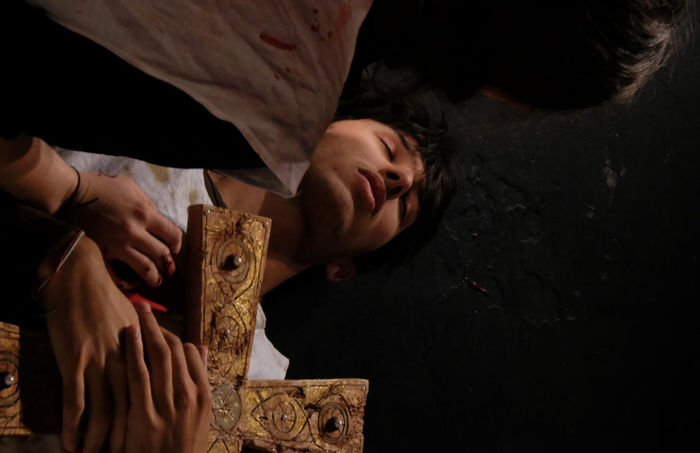Request Programme offers wordless insight, but risks over-punishing its audience
This impressively acted play finds itself running out of things to say

There is a voyeuristic fascination to watching someone who believes themselves to be unobserved. That the wordless Request Programme had a room full of students captivated by a woman silently packing away her shopping for five minutes is remarkable, but perhaps, on second thought, not that surprising. After all, we can’t help but speculate about another person’s life using clues we can glean from their private moments. This play exploits that tendency towards curiosity in order to position its audience closer to another state – empathy.
The plot is simple: in real time, we watch an ordinary woman spend a seemingly ordinary evening alone in her apartment, from the moment she comes home from work until she goes to bed. Though she never utters a word (a conceit which, though intentional, risks wearing thin over this production’s hour-long runtime) we build up a sufficient understanding of the loneliness that will drive her to quietly take her own life at the end of the night.
“Olivia Kiely is brisk and efficient in the role, intensely focused on her routine”
Franz Xaver Kroetz’s Request Programme was first performed in the early 1970s, and its use of silence is emblematic of several of his most important works. It has since been reproduced with contemporary updates to the character’s life; in this modernised production directed by Eoin McCaul, she browses a laptop and listens to a newscast on last week’s reporting of the Ukraine war.
Olivia Kiely is brisk and efficient in the role, intensely focused on her routine of unpacking foodstuffs, making a simple dinner and applying her evening skincare. She only occasionally allows glimpses of emotion to slip through, such as a wry chuckle to herself at a comment on the radio. Hints of melancholy start to seep in during long stretches of silent smoking or listless fiddling with the radio controls, contrasting with other moments that sometimes struggle to fill the silence with substance. In several moments, Kiely freezes from her actions, as if confronting the emptiness of the evening ahead. These are followed by a quick leap to yet another activity designed to plug the gap. As the minutes crawl by, the show asks what happens if your daily routine is not a chore to get through, but the only thing you have to fill your time?
“In the affected subtlety, there is a lack of tension and pay-off ”
Knowing the outcome going in, I was curious to see how Kiely’s stoic performance would translate into the climactic moment of emotional crisis. The slow creep towards her decision was interesting – first she cannot sleep, so takes one sleeping pill. Then she decides to read the instructions. In response to what she reads, she counts the pills left. As if daring herself to go further, she refills the glass of water … and so on. Her decisions felt consistent with the character we had come to know by that point – tidy and restrained, just taking the logical next step. That said, it is here that the play’s minimalist approach to direction faces hurdles. By deliberating giving little away throughout, the deeper logic system underpinning our heroine’s suicide is obscured. In the affected subtlety, there is a lack of tension and pay-off – and for all the play’s intimacy, there’s little to gesture at the inner life that propels her to her final decision.
Since the play is essentially one woman interacting with her environment, the set design is key to our understanding of events. Three lamps and a mirror transformed the small stage into a seemingly larger apartment. During the periods of stillness, details about the furniture and items scattered about allowed the audience to deduce information about the character. The passage of time, while laborious and at times punishing, was made visually clear in both a digital bedside alarm showing the real time, and a water jug that was slowly emptied over the hour.
“The play invites a deeply personal response from each audience member”
With the chairs positioned on three sides around a kind of thrust stage, everyone effectively had a front-row seat – but not all seats were equal. This is my main gripe: the table where Kiely spends the majority of the play was at the front corner, protruding out into the audience, and she was often seated in such a way that at least one third could not see her face or actions, resulting in many craned necks. This was not only a problem for the extended dinner and painting scenes, where the drama lay in observing her minute reactions to the radio broadcast, but most especially for the pivotal suicide scene – the crisis she goes through is essentially hidden from a large part of the audience. This felt like a surprising oversight given the attention to detail in the rest of the set. It’s a tricky challenge to balance the realism of the environment with accessible viewing – but the priority of the former over the latter here is significantly consequential, and diminishes much of the play’s power.
Request Programme is meant to be challenging. Personally, I wonder whether I would have been more moved had the signs of impending tragedy been more overt - the deliberate lack of explanation feels frustrating as a consequence. Nonetheless, by the nature of those long silences, the play invites a deeply personal response from each audience member. Perhaps the marker of a compelling production is simply one which gives the viewer that space to immerse themselves in someone else’s life – in this regard, at least, BATS has succeeded.
‘Request Programme’ is showing at the Fitzpatrick Hall from Tuesday 19th until Thursday 21st November, at 7:30pm.
 Features / Should I stay or should I go? Cambridge students and alumni reflect on how their memories stay with them15 December 2025
Features / Should I stay or should I go? Cambridge students and alumni reflect on how their memories stay with them15 December 2025 News / Cambridge study finds students learn better with notes than AI13 December 2025
News / Cambridge study finds students learn better with notes than AI13 December 2025 News / Uni Scout and Guide Club affirms trans inclusion 12 December 2025
News / Uni Scout and Guide Club affirms trans inclusion 12 December 2025 Comment / The magic of an eight-week term15 December 2025
Comment / The magic of an eight-week term15 December 2025 News / News In Brief: Michaelmas marriages, monogamous mammals, and messaging manipulation15 December 2025
News / News In Brief: Michaelmas marriages, monogamous mammals, and messaging manipulation15 December 2025









